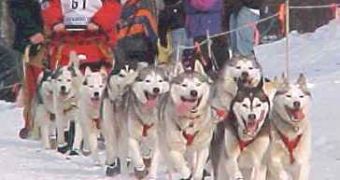Sled dogs, like the Samoyed (western Siberia), Alaskan Malamute, Canadian Eskimo Dog and Greenland Dog, are generally called Husky, but the only variant officially recognized as a breed is the Siberian husky (a better term for naming northern dogs is "spitz").
The Siberian husky was used by the nomad Inuit (Eskimo) people even 3,000 years ago in northeastern Siberia for sled traction and for guarding the reindeer herds. Isolated because of the harsh northern conditions, this breed remained amazingly pure.
Around the year 1900, fur traders brought this dog from Siberia to Alaska. Because of the increasing interest for sled races and the growing number of titles won by the Siberian husky, more dogs were brought from Siberia. The breed was homologated in the '30s.
The origin of the name of Husky is not known; some say it refers to the deep and distinct howl of the animal, while others consider it to come from the Chukchi or Tsuki Inuits of the Siberia, meaning"raw-meat eater", as the drivers fed them with dry fish. The powerful and graceful husky is the favored of the dog sled races, having won various titles.
Husky is an excellent team dog, which rarely fight with the other harness "colleagues", this gentle and affective dog being the most docile sled dog.
The fur is dense, soft, medium sized and beautiful, while the blue-ice or brown bright and oblique eyes have a friendly expression, making it one of the most attractive dogs of the north. Many huskies are affected by heterochromia, a condition in which the two eyes have different colors (usually, one is brown and the other blue).
Husky carries more wolf genes than other dogs, and it must be treated gently if the master does not want to awake some ancestral aggressive instincts. Unlike other dogs, this breed is very clean and does not have the bad smell. The coat does not require special care, but it must be brushed with a metal comb during the molting period.
The Siberian husky is small, the male being up to 60 cm (2 ft) tall and weighing 20-27 kg (44-60 pounds), while the female up to 56 (1.9 ft) tall, weighing 15-22 kg (32-50 pounds). The ears are medium, triangular, straight and raised. The back is straight and the tail is bushy, worn raised when running and lowered when working or resting. This rapid and intelligent dog has straight, muscled limbs, with heels close to the ground.

 14 DAY TRIAL //
14 DAY TRIAL //